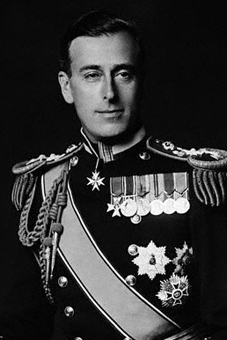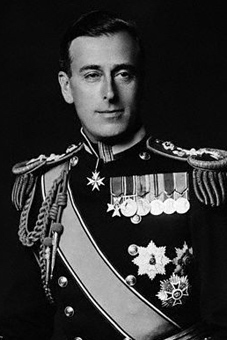
Finest Hour 168
World War II—Honours

September 6, 2015
Finest Hour 168, Spring 2015
Page 15
By Paul H. Courtenay
A quick guide to the titles of honour awarded to high-ranking officers during or after the Second World War

2024 International Churchill Conference
KNIGHTHOODS
There were seventeen different levels of knighthood at this period (though only four which were normal within the military); today this number has been reduced from seventeen to twelve, with the same four being normal. The latter, in ascending order of precedence, are:
Knight Commander of the Most Excellent Order of the British Empire [KBE]
Knight Commander of the Most Honourable Order of the Bath [KCB]
Knight Grand Cross of the Most Excellent Order of the British Empire [GBE]
Knight Grand Cross of the Most Honourable Order of the Bath [GCB]
KBE and KCB denote the Second Class of their respective orders; GBE and GCB denote the First Class. Because the Order of the Bath is senior to the Order of the British Empire, it follows that GCB is slightly better than GBE, and KCB is slightly better than KBE.
The normal procedure was for a three-star officer (Vice Admiral / Lt General / Air Marshal) to become KCB or KBE; in a few special cases two-star officers (Rear Admiral / Major General / Air Vice-Marshal) might receive one of these awards. Appointments in the Order of the Bath would be more likely to go to those in mainstream posts, such as Corps commanders and equivalent; appointments in the Order of the British Empire might go to those of three-star rank in staff or support roles. This was by no means a general rule, but gives some idea of possible distinctions between one order and another.
Four-star officers (Admiral / General / Air Chief Marshal) would be likely to be appointed to the First Class of one of the orders, either to the one to which they already belong or to the other order.
PEERAGES
As far as World War II is concerned, we need consider only the three lowest degrees: baron, viscount and earl. Listed with the highest military ranks they ultimately attained, those awarded peerages were:
Royal Navy
AF Sir Andrew Cunningham: C-in-C Mediterranean Fleet 1939–42 and 1943; First Sea Lord 1943–46. Created Baron Cunningham of Hyndhope 1945; advanced one degree to become Viscount Cunningham of Hyndhope, 1946.
 AF Lord Louis Mountbatten: Chief of Combined Operations 1941–43; Supreme Allied Commander South East Asia 1943–46; Viceroy of India February–August 1947 / Governor General 1947–48; First Sea Lord 1955–59; Chief of Defence Staff 1959–65. Created Viscount Mountbatten of Burma, 1946. On the independence of India in 1947 his role there changed from Viceroy to Governor General, when he was advanced one degree to become Earl Mountbatten of Burma.
AF Lord Louis Mountbatten: Chief of Combined Operations 1941–43; Supreme Allied Commander South East Asia 1943–46; Viceroy of India February–August 1947 / Governor General 1947–48; First Sea Lord 1955–59; Chief of Defence Staff 1959–65. Created Viscount Mountbatten of Burma, 1946. On the independence of India in 1947 his role there changed from Viceroy to Governor General, when he was advanced one degree to become Earl Mountbatten of Burma.
AF Sir John Tovey: C-in-C Home Fleet 1940–42; C-in-C The Nore 1943–46. Created Baron Tovey, 1946.
AF Sir Bruce Fraser: C-in-C Home Fleet 1942–44; C-in-C Pacific Fleet 1944–46; First Sea Lord 1948–51. Created Baron Fraser of North Cape, 1946.
Army
FM Viscount Gort: C-in-C British Expeditionary Force 1939–40. He already held a hereditary viscounty in the peerage of Ireland (which gave no entitlement to a seat in the House of Lords); in 1946 he was given a further viscounty with the same title in the peerage of the United Kingdom, which gave him a seat.
FM Sir Edmund Ironside: CIGS 1939–40. Created Baron Ironside, 1941.
FM Sir Archibald Wavell: C-in-C Middle East 1939–41; C-in-C India 1941–43. Created Viscount Wavell, 1943. After his tenure as Viceroy of India in 1943–47, he was advanced one degree to become Earl Wavell.
FM Sir Alan Brooke: CIGS 1941–46. Created Baron Alanbrooke, 1945. Advanced one degree to become Viscount Alanbrooke in 1946.
FM the Hon Sir Harold Alexander: C-in-C Middle East 1942–43; Supreme Allied Commander Mediterranean 1944–45. Created Viscount Alexander of Tunis, 1946. After his tenure as Governor General of Canada in 1946–52, he was advanced one degree to become Earl Alexander of Tunis.
FM Sir Bernard Montgomery: C-in-C 21st Army Group 1944–46; CIGS 1946–49. Created Viscount Montgomery of Alamein, 1946.
FM Sir Henry Maitland Wilson: Supreme Allied Commander Mediterranean 1943–44. Created Baron Wilson, 1946.
FM Sir William Slim: Commander XIV Army (Burma) 1943–45; CIGS 1949–52. After his tenure as Governor General of Australia in 1953–60, he became Viscount Slim. Slim was relatively junior in Burma. Though in command of an Army, there were two levels of command above him in the Far East. He actually retired from the Army in May 1948, but was recalled to become CIGS in January 1949.
General Sir Hastings Ismay: Chief Staff Officer to the Prime Minister (as Minister of Defence) 1940–46; First Secretary General of NATO 1952–57. Created Baron Ismay, 1947.
Lt Gen Sir Bernard Freyberg VC: Commander, New Zealand Expeditionary Force in Crete, North Africa and Italy 1941–45. In 1951, near the end of his tenure as Governor General of New Zealand in 1946–52, he became Baron Freyberg.
Royal Air Force
MRAF Sir Cyril Newall: Chief of Air Staff 1937– 40. After his tenure as Governor General of New Zealand in 1941–46, he became Baron Newall.
ACM Sir Hugh Dowding: C-in-C Fighter Command 1936–40. Created Baron Dowding, 1943.
MRAF Sir Charles Portal: Chief of Air Staff 1940–46. Created Baron Portal of Hungerford, 1945. Advanced one degree to become Viscount Portal of Hungerford in 1946.
MRAF Sir Arthur Tedder: Deputy Supreme Allied Commander Europe 1944–45; Chief of Air Staff 1946–50. Created Baron Tedder, 1946.
MRAF Sir Sholto Douglas: C-in-C Fighter Command 1940–42; C-in-C Coastal Command 1944–45. Created Baron Douglas of Kirtleside, 1948.
MRAF Sir Arthur Harris: C-in-C Bomber Command 1942–45. Received no peerage, though he was advanced from KCB to GCB in 1945. It was said that he refused a peerage because Bomber Command aircrews had been denied a special campaign medal of their own. He was made a Baronet (a hereditary knighthood that made him Sir Arthur Harris Bt) in 1953 during Churchill’s premiership of 1951–55.
ORDER OF THE GARTER / ORDER OF THE THISTLE
Of the above, the following were also appointed Knights Companion of the Most Noble Order of the Garter: Mountbatten 1946, Brooke 1946, Alexander 1946, Montgomery 1946, Ismay 1957, Slim 1959, Portal 1946.
Cunningham, being a Scot, was appointed to the Most Ancient and Most Noble Order of the Thistle (Scotland’s equal to the Garter) in 1945.
NOTES
The three Chiefs of Staff (Cunningham / Brooke / Portal) were initially given the lowly degree of Baron; these awards were made in September 1945 when the war had very recently ended. They were all advanced one degree to become Viscounts in January 1946; among other factors, this ensured that their subordinates (Mountbatten / Alexander / Montgomery) who were made Viscounts later in 1946 could not out-rank them.
Pro-consular service in the Empire and Commonwealth as Viceroy or Governor General, often subsequent to the award of honours for military service, regularly earned an advancement to a higher degree in the peerage than that already bestowed.
Paul H. Courtenay is a Senior Editor of Finest Hour.
Subscribe
WANT MORE?
Get the Churchill Bulletin delivered to your inbox once a month.


